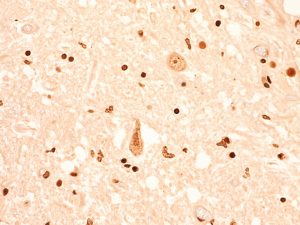
A new detection method for amyotrophic lateral sclerosis (ALS) and frontotemporal dementia (FTD) using single-stranded RNA aptamers to selectively detect TDP-43 protein aggregates.
Application
Development Status
IP Status
Commercial Offerings

Opportunity
ALS is a highly debilitating and fatal neurodegenerative disease affecting motor neurons, leading to the loss of voluntary limb function, and breathing and swallowing problems. Early detection of ALS neurodegeneration can provide a chance for an early treatment to delay further progression of the disease.
Currently, there are no approved diagnostic tests available for ALS and the disease often goes undetected until late-stage symptom onset. For diagnosed ALS patients, disease progression tracking mainly involves subjective patient self-assessment and the use of muscle strength tests. While the muscle strength test is a quantitative measurement, it can only be used in very late-stage disease progression.
Edinburgh’s technology has the potential to increase the possibility of early detection, diagnosis and intervention by helping to identify and follow treatment effectiveness in clinical trial participants. The technology has been shown to detect TDP-43 aggregates of different sizes, indicating its potential to be used in disease progression tracking as well as early detection of ALS.
Technology
TDP-43 is known to accumulate in non-central nervous system tissues prior to symptom onset in neurodegenerative diseases such as ALS and FTD. A common pathological feature observed is the depletion of TDP-43 in the cell nucleus and the accumulation of TDP-43 in the cytoplasm of affected neurons. These toxic aggregates will gradually increase in size and have been proposed to be an early indication of the disease.
The TDP-43 RNA aptamers are capable of binding to and detecting TDP-43 aggregates of different sizes, allowing the identification and quantification of all TDP-43 aggregate species, from the smallest oligomers (20 nm) to the largest aggregates (1-2 micrometres). These aptamers show the potential to be used as molecular probes for the early detection of TDP-43 protein aggregates and the subsequent diagnosis of TDP-43-related neurodegenerative diseases, such as ALS and FTD.
Benefits
Publications
Zacco, E et al. Probing TDP-43 condensation using an in
silico-designed aptamer. Nat. Commun. 13(1):3306. doi:
10.1038/s41467-022-30944-x (2022).
Please note, the header image is purely illustrative.
Quote: TEC1104423

Senior Technology Transfer Executive
College of Science and Engineering
College of Medicine and Veterinary Medicine